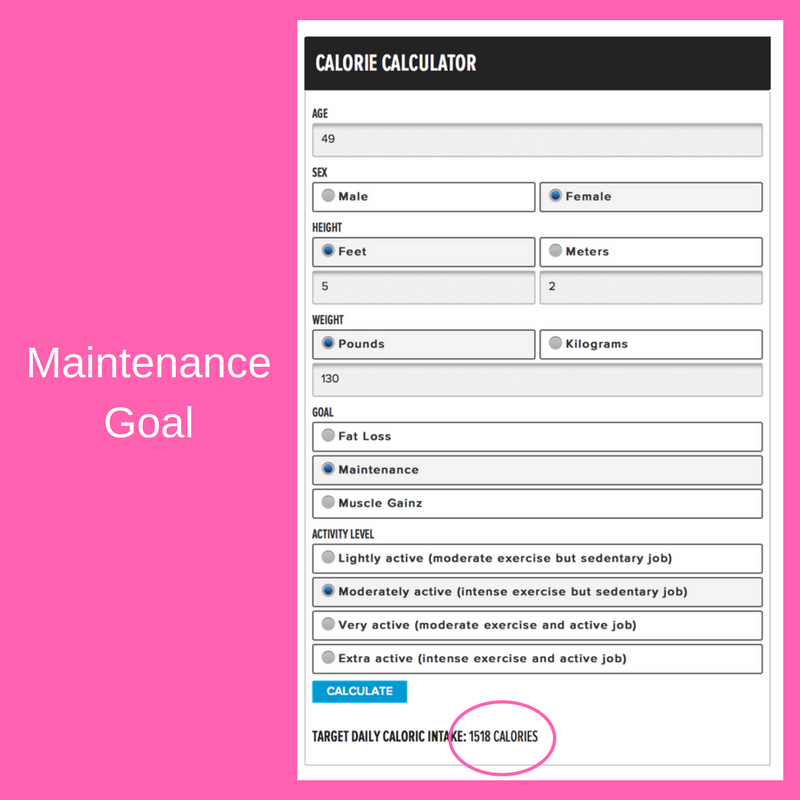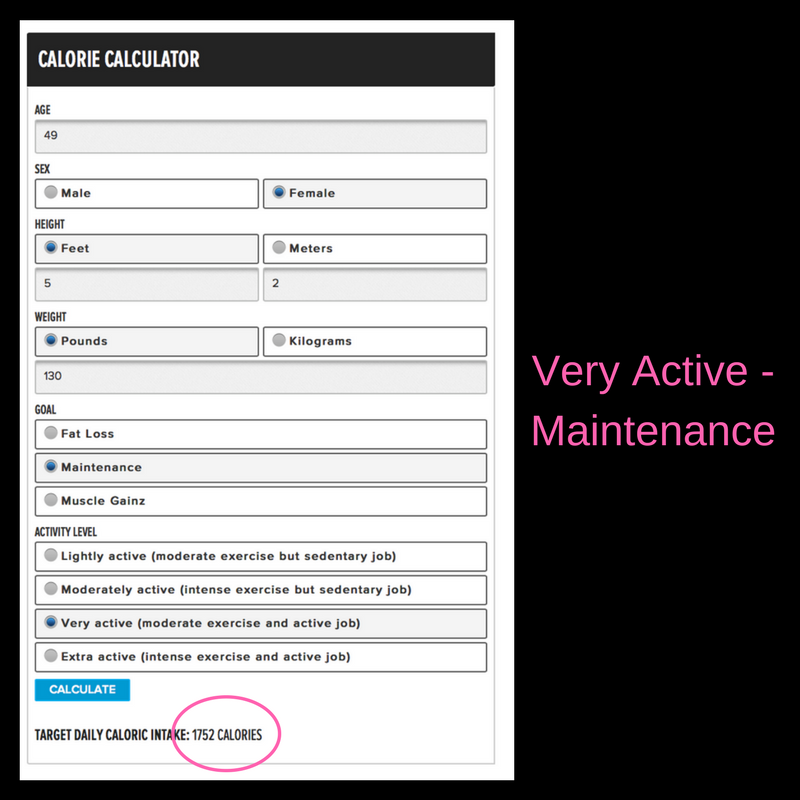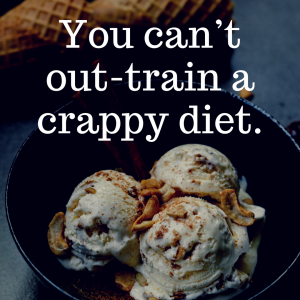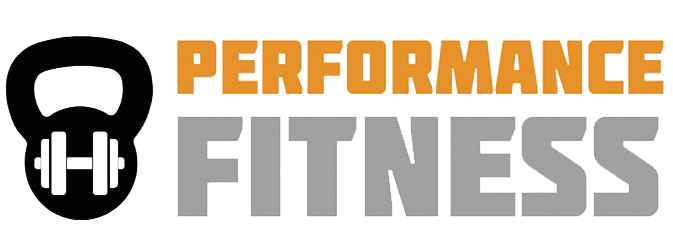So You’re Ready to Track Your Calories. Now What?
A Guide to Documenting Your Food and Drink
How many calories should you be eating in order to achieve your desired physique? It all depends on you, specifically, your goals, gender, age, weight, height and activity level. These are all bits of information you will plug into any number of online calorie calculators to find out your daily calorie requirement.
All of these calculators use the same algorithms to determine your needs. Just choose the one that suits you.
The calculator from Bodybuilding.com is straightforward. For today’s post, we’ll use it, but feel free to research on your own and let me know what you find.
Here is an example of a 130-pound woman who’s 49 years old, is 5’2”, wants to lose fat and is moderately active, meaning, she comes to boot camp or kettlebell classes a few times a week, but has a desk job. It is suggested by this calculator that she eat 1366 calories a day.

She could do this by eating three 455 calorie meals a day, or five 273 calorie meals a day or any permutation that suits her habits, needs and desires.
If this same woman didn’t want to lose scale weight but instead wanted to build muscle while losing fat, then she’d choose “Maintenance” as a goal (rather than “Fat Loss”) and her calorie count would rise to 1518.

This way, through her resistance training, she would use the calories she consumed to build muscle while at the same time losing some fat. This is a great way to get to eat and lose fat at the same time. You just have to make sure that you challenge your muscles to grow by using heavy weights for about 3-6 sets of 4-12 reps. This range is not written in stone, but it’s a good gauge, aiming for about 25 total reps for any given exercise, with no fewer than 3 or 4 sets. Aim to strength train 3-4 times per week.
Compound lifts that utilize multiple muscle groups are great for gaining muscle and losing fat efficiently. Compound lifts include squats, deadlifts, pull-ups, push-ups, overhead presses, bench presses, and all lunging variations. Think of compound lifts as movements that require you to bend more than one joint at a time. Examples include hips, knees and ankles for squats, and elbows and shoulders (and a little hip) for pull-ups. By contrast, a bicep curl only requires a bend in one joint—the elbow. It requires less energy to complete, won’t leave you winded and is therefore not as efficient a calorie-burning or muscle-recruiting exercise, though it makes a great accompaniment to a session that includes the “big lifts.”
Big lifts are also renowned for something called EPOC, or excess post-exercise oxygen consumption, which is a fancy way of saying that you burn additional calories at rest after an intense strength-training or HIIT session—more than you do after a long jog. You can read more about EPOC here.
Back to calorie tracking!
 Our 49 year-old friend has just informed me that she walks briskly every day, getting in 10K+ steps easily. She is rarely at her desk at work, always moving around, and therefore, the “moderately active” activity level should be “very active.”
Our 49 year-old friend has just informed me that she walks briskly every day, getting in 10K+ steps easily. She is rarely at her desk at work, always moving around, and therefore, the “moderately active” activity level should be “very active.”
I hesitate to allow this since people tend to overestimate their activity levels, and thereby overeat, but I’m willing to at least see what the numbers say. For maintenance, this would bring her daily calorie requirement to a comfortable 1752, which is very attainable, and will bring her the results she wants, as long as she remains very active. If she enjoys a day of leisure, she could simply eat a lower amount of calories on that day, and not gain any weight.
Just a quick alert before moving on: starving yourself is NOT the answer. If you simply want to try to eat as few calories as you can, you will wreck your metabolism, sleep and energy levels, and become intolerable to everyone who comes into contact with you.
Your BMR, or Basal Metabolic Rate, represents the amount of calories your body needs at complete rest—for things like digestion, and for your heart to beat. Based on this calculator my BMR is 1256, which ironically is roughly how many calories a lot of so-called experts tell women of all ages, sizes and activity levels to eat for weight loss. Don’t buy that load of generic malarkey. Use a calorie calculator to figure out your specific needs.
So after all that calculating, what should our friend eat?
Let’s talk MACROS.
Macronutrients, or macros, as they’re frequently referred to are your proteins, carbohydrates and fats.
PROTEIN
In the world of fat loss and muscle-building, it is typically recommended that you eat one gram of protein for every pound that you weigh. For our 130-pound woman, this would equal 130 grams of protein, spread throughout the day.
If you weigh 200+ pounds, do not eat your weight in protein grams. Instead, aim for your goal weight, OR for your current weight multiplied by .7 to .8. So, if you weigh 200 pounds and you’re using the second formula (.7 to .8 x current weight), your protein goal would be 140 to 160 grams per day.
If you’re training seriously for a powerlifting meet, Olympic lifting meet, or the Crossfit Games, then you can readjust and use the one gram per pound formula. But if your goal is simply to gain strength, add muscle, and lose fat, .7 to .8 grams per pound of current bodyweight OR one gram per pound of goal weight will be plenty. Also know that in the beginning, if you’re not used to eating generous helpings of protein, aim to succeed. Make your target 90-100 grams a day. Once you’ve mastered that, then slowly increase the amount of protein you’re eating, especially if you find yourself sore from workouts or frequently ravenous.
In terms of percentages, you’ll be eating roughly 30% of your total calories in protein. I also go for 30% carbs and 40% fat, but that’s more subjective and can be played with a little more.
MATH (Bear with me.)
Since one gram of protein equals 4 calories, our friend would be eating 520 calories a day from protein. For three meals a day this would equal 173 protein calories, or 68 grams of protein per meal. This is A LOT of protein to eat at one sitting. I average 25-30 grams myself per meal—less than half that amount. This means that our friend will need some protein-rich snacks.
Now if our friend ate five meals a day, she’d only have to eat 26 grams of protein per meal. This is way more realistic and sustainable. This could mean three larger meals plus two small but protein-rich snacks. There are TONS of protein powder snack recipes out there if you don’t want to give up sweets. Head over to Pinterest and take a look.
The most protein-dense food sources are meat, fish, eggs, soy, Greek yogurt, cottage cheese, and protein powders like whey, hemp and pea. Vegetarians looking to nuts or cheese for a primary protein source will get more fat than they bargained for, while beans will give them more carbs. Make sure that when shopping for protein, that PROTEIN is the main source of calories. It seems like DUH, but I can’t tell you how many vegetarians (2) tell me that beans are their main source of protein, and I bet you a thousand dollars they are not aiming for 1 gram per pound of bodyweight. Read those labels, warriors.
Additionally, if our buddy comes close to 130 grams per day but doesn’t nail it, it’s fine. In fact, I would tell her to eat anywhere from 115 to 135 grams and not worry about it too much, as long as she’s aiming high and getting close.
If for some reason she consistently eats UNDER her goal amount of protein, she will have a harder time sticking to her program. For one thing, she is more likely to overeat, since protein is very satiating. Furthermore, all her hard work will not show, since muscle mass depends on protein—when you strength train you are damaging muscle tissue at the microscopic level. During rest and recovery from exercise, muscle tissue heals and grows. Without adequate protein intake, the muscles will remain in the damaged state and not get any bigger.
 It’s enough to make me cry to see someone who dedicates themselves to their training, only to throw it all away because they won’t take the time to make sure they’re consuming enough protein and hit their calorie count. This is the technical explanation for the maxim, “You can’t out-train a crappy diet.”
It’s enough to make me cry to see someone who dedicates themselves to their training, only to throw it all away because they won’t take the time to make sure they’re consuming enough protein and hit their calorie count. This is the technical explanation for the maxim, “You can’t out-train a crappy diet.”
CARBS AND FATS
Carbs also contain 4 calories per gram, while fat boasts a whopping 9 calories per gram. This is one reason fat has been vilified over the years as the number one source of obesity and partly where the low-fat diet craze came from. You can tell by the obesity epidemic that no one lost weight cutting out fat from their diets, because they just replaced those satiating calories with carbs (Snackwells anyone?), gained weight, and thus the low-carb diet craze was born. (Incidentally, alcohol has 7 calories per gram.)
I’m of the mind, as a trainer, nutrition coach and human being who has had both success and failure while trying to lose a few pounds, that eating enough protein is the most effective way to achieve your goals. I talk extensively about this here. After you’ve figured out your protein, what’s left over gets split between carbs and fats, which are both vital to your health, energy, satiety and happiness.
This is where I get way more intuitive with things. Some people swear by a low-carb or paleo diet (Crossfitters come to mind), and others love their carbs but eschew high-fat food (bodybuilders). I fall somewhere in the middle. I love full-fat dairy, avocado, coconut spread and nut butters, and will not give them up because a meal without fat, for me, is not filling or satisfying. It’s easier and more realistic for me to eat fewer carbs. Less sandwiches, pasta and cake is fine with me. But I don’t eat low-carb either because that would be its own brand of torture. I love a piece of sprouted toast with my three-egg omelet, a banana in my smoothie, and I’m a sucker for any root vegetable you can name, preferably roasted in the oven with olive oil and Celtic sea salt. I just aim to eat my allotted calories, letting fats and carbs fall where they may, after building each meal around a reputable protein source.
I also try to eat the protein portion of my meal first, so that I’m somewhat satiated before I dive into my carbs. Then I track everything. Or, sometimes, especially if I’ve eaten more than usual earlier in the day or haven’t worked out, I will plug in the meal I’m about to eat BEFORE I eat it, so that I can determine how much I really can consume without derailing my progress.
One last trick before I leave you—if you are scared by the calorie count you are given for the fat loss goal, because it seems too low to attain day in and day out, plug in the maintenance goal and subtract 100 from it. You’ll still be in a caloric deficit but not as large of one. Additionally, you could increase your activity level. Invest in a fitness tracker and make a game out of getting your steps in every day. Supplement your workouts with long walks or hikes. Find a great podcast, slip on a pair of headphones and clean the house. Find ways to move to increase your NEAT (Non-Exercise Activity Thermogenesis—or “ways we burn calories without formally exercising”) and thus help you to burn a couple hundred more calories than you consume.
With the right tools, you CAN achieve your goals. So go on and pop your info into a calculator. Be honest about your activity level, see what it says, and keep us posted. A month of sticking to your calorie count, including tracking, adequate protein consumption and 3-4 days of strength-training WILL result in success!
